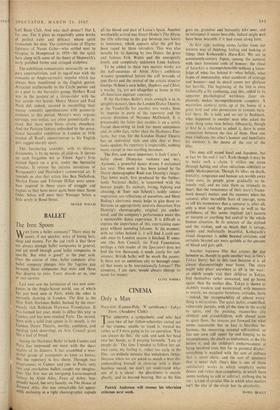ART The Nineteen-Thirties
WHEN John Raymond revived interest five years ago in the intellectual and political currents of thought in the Baldwin Age, my
chapter in his symposium dwelt on the lively debates of the conflicting and intersecting art circles of the Thirties. Bloomsbury was influen- tial still, and Clive Bell resonantly vocal. Herbert Read, opposed to Bloomsbury, was stimulating a small, active following for his Hampstead neigh- bours Henry Moore, Ben Nicholson and his wife Barbara Hepworth. Sickert was lonely now, and Wyndham Lewis an aggressive one-man-band. The popular newspapers loudly derided any in- novation, believing that the contentious Epstein somehow personified the crazy modern move- ment. Reason happily survived in the periodical criticisms of Kenneth Clark, Geoffrey Grigson, Edward Crankshaw, and more polemically in the perceptive writings of Paul Nash. In that decade of political revolution in the shadow of world war, English art (I knew at first hand) was really all loose strands grasped at moments by different leaders. But art history abhors confusion. It selects and inevitably falsifies for the sake of order.
The first tidy parcelling of British art in that strident decade was the Arts Council's absorbing exhibition at the National Museum in Cardiff in 1962. This led us through all the uneasy alliances, divergences and revolt at length from formal theory of the Euston Road realists: a recall to the current actualities of a muted, sandbagged London where café bars suddenly meant more than abstract compositions. The latest account of art in Britain in the 1930s at both Marlborough Galleries provides a narrower conspectus. It concentrates on the publications Axis, Circle, and Unit One, and the group of artists asso- ciated with them, and principally with Herbert Read in Hampstead. Introducing this company afresh with all the persuasiveness of his initial championship in The Listener, Read presents us with the counterpart of a political analysis of the period restricted to Laski, Gollancz and his
Left Book Club. And who shall demur? Not I, for one. For it gives us expectedly some works of perfect -calm and delicacy whose spirit transcends the time. The constructions of filigree lightness of Naum Gabo—who settled next to Gropius in Hampstead in 1935—lift the spirit here along with some of the finest of Hepworth's early polished forms and stringed sculpture.
The exhibition concentrates necessarily on this pure constructivism, and its tug-of-war with the romantic or Anglo-surrealist impulse which has always been manifested in the English genius. Attracted intellectually to the Circle purists and as a poet to the Surrealist group, Herbert Read was in the posture of a circus-rider with his feet astride two horses. Henry Moore and Paul Nash did, indeed, succeed in reconciling their uneasy romantic apprehensions with geometric elements at this period. Moore's wary organic carvings, you notice, are often geometrically in- cised. But there were fierce strains elsewhere. And the Parisian fantasy unleashed by the sensa- tional Surrealist exhibition in London in 1936 needed all Read's equestrianism as his English pair tugged sharply apart.
This fascinating assembly, with its historic documents, is by no means all déjà-vu. It throws up such forgotten wit as Eileen Agar's little jointed figure on a grid, under the Surrealist stimulus. It revives the incisive inventions of Reinganum's and Havinden's commercial art. It reminds us also that artists like Ben Nicholson, Merlyn Evans and Tristram Hillier were some- how inspired in those years of struggle and neglect as they have never quite been since. Some Older Selves will meet their Younger Selves a little wryly in Bond Street.
NEVILE WALLIS















































 Previous page
Previous page